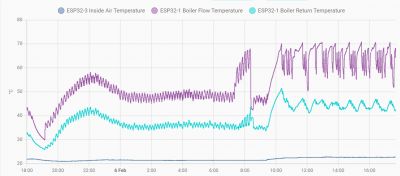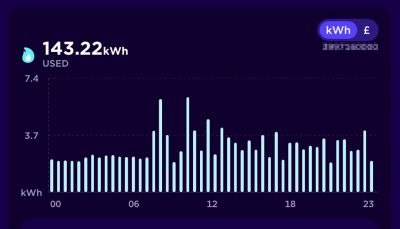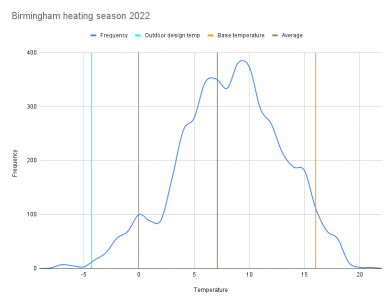Migrating from boiler to heap-pump; balancing radiators and UFH
@tomasmcguinness I saw your YouTube video about radiator balancing and I'm looking forward to seeing developments
I attach my boiler flow and return temperatures over the last 24 hours. The left-hand side is operation with my Drayton controller and the right-hand side with no Drayton controller. DHW came on around 7am. The Drayton controller is now obsolete and Drayton will shortly be stopping cloud services so it will then become 'dumb' and I am trying to decide whether or not to replace it.
That looks about right. The Drayton slowly increased the temp by firing the boiler for short periods before it settled down. On the other side, the boiler just goes to full blast and cycles when the return temp gets too high.
Have you compared the gas usage on either side? It would be interesting to see the cost of letting the boiler cycle vs letting the Drayton turn it on and off.
Owner of a ridiculously oversized 35kW boiler and trying to make it as efficient as possible. 4.8kW solar PV with 5.4kWh storage. EV driver.
Follow my journey at https://www.youtube.com/@tomasmcguinness
Next big project is a heat pump!
@tomasmcguinness My concern with operation via the Drayton is the wear on the gas valve considering it turns on and off every 10 minutes. Regarding operation without the Drayton, I thought modulation in a boiler was supposed to produce a variable flame, not a boolean one. I know this boiler has a variable speed fan in it.
Gas consumption is certainly more stable with the Drayton. It's difficult to say from the attached graph alone, but I'd say consumption is slightly more. This correlates with the indoor temperature increase, too. If I can bring the indoor temperature down then I suspect there would be little if any difference in cost (it's difficult to assess on a day-to-day basis). Incidentally, I've realised that the usual running cost comparisons of boiler versus heatpump are rather more complicated when on agile and gas tracker tariffs. This will obviously change as energy policy taxes change in the future.
Modulation is supported in most boilers, but they have limits. My boiler, for example, can go between 35kW and 5.5kW. That's a range of 100% to 15%.
The boilers job is to lift the temperature of the water coming back into it up to the desired temp. In a condensing boiler setup, it will usually try and lift the water from say 50 to 70 as that's your desired flow temperature.
When the boiler starts, the return will be quite cold (most likely ambient temp) so the boiler will work hard to get it from 20 up to 70.
As the return temperature starts to rise, the boiler will reduce the amount of heat it needs to put into the water, maintaining flow temperature e.g. 70.
However, if the return temperature starts to get too high (because your radiators cannot dissipate enough heat), the boiler will turn the flame off. It will keep circulating the water until the return temperature drops far enough before the flame turns on. This is cycling.
It's bad in a boiler but it's terrible in a heat pump!
Owner of a ridiculously oversized 35kW boiler and trying to make it as efficient as possible. 4.8kW solar PV with 5.4kWh storage. EV driver.
Follow my journey at https://www.youtube.com/@tomasmcguinness
Next big project is a heat pump!
@tomasmcguinness a thermal store can help to reduce cycling / increase utilisation. Using dual stats top and bottom is helpful - appliance comes on only when the high stat goes below limit, and then off when bottom stat goes over limit (or when the return to the appliance is satisfied).
Looking at our heating season temperatures is interesting (well to me anyway 😀 ) - here I've marked the outdoor design temp as defined in BS12831. It leads to a lower temperature than if using the Cibse method. It's also calculated over 20 years and climate change has a definite effect over that period. Base temperature isn't accounted for when calculating the peak load using 12831 - so that all contributes to oversizing, even when the appliance is "correctly" sized.
(MCS framework currently refers to 12831, apart from the outdoor design temp which refers to Cibse.)
Great to hear about the changes you're making to your system in preparation, and your youtube channel looks excellent although so far I've only found time to look at one of the many uploads. I imagine that your control system will be able to track electricity prices and adjust the flow temperatures of a heat pump once you get to that stage?
Planning your dream house? Book a simple one-to-one consultation to get you on a good path - here.
- 26 Forums
- 2,396 Topics
- 54.3 K Posts
- 88 Online
- 6,077 Members
Join Us!
Worth Watching
Latest Posts
-
RE: Recommended home battery inverters + regulatory matters - help requested
Thanks for all the help/comments. I completely agree w...
By JamesPa , 2 hours ago
-
RE: Help me keep the faith with my air source heat pump installation
I agree and that’s why I don’t believe a lot o...
By SimonF , 6 hours ago
-
RE: ASHP Energy Consumption: Aira 12kW heat pump
I doubt that matters, ToU tariffs are for the benefit o...
By JamesPa , 7 hours ago
-

RE: Free Ecoheat Heat Pump Install
@deltona Yes older houses are problematic like that, bu...
By bontwoody , 10 hours ago
-
RE: Radiator sizing sanity check
As I mentioned early on the cost of supplying and fitti...
By JamesPa , 13 hours ago
-
RE: Advice for a novice on Mitsubishi Ecodan 6kW
I hadn't spotted that there were two pumps in the UFH (...
By JamesPa , 14 hours ago
-
RE: Setback savings - fact or fiction?
Never assume it makes an ass of u and me! You need the...
By JamesPa , 15 hours ago
-
RE: New Mitsubishi Ecodan 11.2kW installation - L9 errors and maybe more
Before I answer your specific questions just one more t...
By JamesPa , 15 hours ago
-
RE: Electricity price predictions
Great point, one of the key ones in my chat with Octopu...
By Batpred , 1 day ago
-
RE: Running from backup generaor in powercut?
Definitely and professionals sometimes miss it. I had...
By Batpred , 1 day ago
-

RE: New Fogstar 15.5kWh upright solution
Let me point out that there are many Chinese suppliers ...
By Transparent , 1 day ago
-

RE: Weather compensation- why you should use it
@majordennisbloodnok — The Two Ronnies Mastermind sketc...
By cathodeRay , 1 day ago
-
Just realised that this image of the cylinder cupboard ...
By Sheriff Fatman , 1 day ago
-

RE: Rodents! A word of warning for heat pump owners
Two thoughts: 1: Let's ask @david-s if Primary Pro in...
By Transparent , 1 day ago
-
RE: Solis S6-EH1P8K-L-PLUS – Why I Chose It and What I’ve Learned So Far
In the diagram below, I describe my understanding of th...
By Batpred , 1 day ago
-
I need to have a look out for it. I know IBM feeds some...
By Batpred , 1 day ago
-
-
RE: Daikin Atherma ASHP Cycling 6 Times an Hour?
Thanks for your reply. Yes that's a good idea to try a...
By John Marshall , 2 days ago
-

RE: Hot water heating in parallel with space heating
An external heat exchanger would need a pump which woul...
By bontwoody , 2 days ago
-
RE: Gen 6 Samsung ASHP losing 20C of DHW in 60 min directly after generation
@ecobaker Thanks for this. I've had it in both slots. ...
By andbeck , 2 days ago







